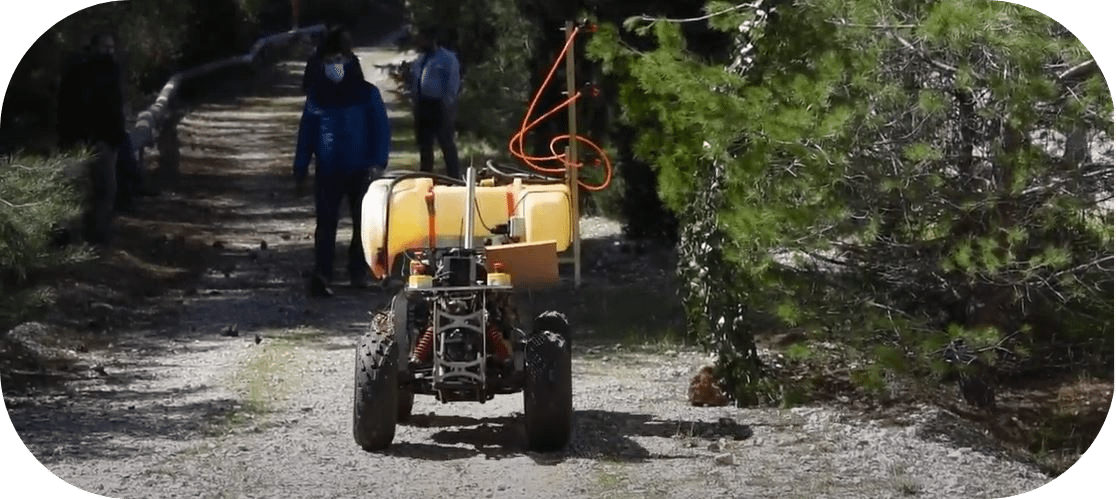Consortium:
Agricultural & Environmental Solutions, National Centre for Scientific Research-Demokritos, Agricultural University of Athens, SCiO
Project Hashtag:
#iRTA
Watch the experiment’s video here.

Overview
Treatment application in steep slope vineyards: Steep slope vineyards account for 10% – 12% of European viticulture land area and produce some of the highest value wines. Row sizes are quite narrow, typically 90cms – 150cms. Currently, where possible, treatments are applied from a small tractor-based system that uses an air-blast system. Losses are high and ground compaction is a problem. What is required is a smaller robot-based system that can access these steep slope vineyards and selectively apply pesticides / fungicides to individual plants.
Such a system would need to:
• Access all areas of a steep slope vineyard autonomously and in all ground conditions, e.g. dry, muddy, etc.
• Optionally, assess the condition of individual vines to assess whether treatment is required.
• Apply treatments to individual plants efficiently and effectively (whether to all vines or only selected ones) achieving spraying losses of 20% or less.
• Be capable of either auto-refilling treatments or notifying an operator when a refill is required.
• Monitor its own energy usage and allow sufficient margin to transfer to facilities where refueling / recharging can take place, i.e. it must not get stranded in the field.
• Be capable of operating for 4-6 hours in any working day.
• Work at a similar rate, or greater, as a person using a manual sprayer.
• Operate safely in the presence of workers, members of the general public, potential obstacles and steep inclines.
• Keep detailed records of treatment rates applied down to individual plant level.
The iRTA robotic platform will combine the following four core functional components:
● a flexible and modular robotic platform, which is based on an All-Terrain Vehicle (KYMCO Maxxer 90 ATV), able to move efficiently into the harsh agricultural environment (including steep slopes), having compact design and achieving small ground compaction. It has the ability to carry >100 kg of payload such as sensors, processing units and implements (e.g. spraying equipment), and work for more than 5 hours. Moreover, it has safety mechanisms both in terms of software and hardware (e.g. stop switches). Finally, it can communicate with a control unit wirelessly for sending and/or receiving information (e.g. position, fuel tank and sprayer tank level, return to home, stop, etc.). During the project, the platform will be improved further for increasing its efficiency and its operation capacity.
● a new autonomous localization, navigation, and obstacle avoidance system will be developed, based on sophisticated environment exploration and situation awareness, allowing the robot to plan and implement an optimal path and to safely operate in the presence of human workers.
● a high-precision sprayer component will be developed, that involves a small capacity tank (approx. 70 lt), a pump for optimum agitation and pressure operating, as well as, drift reduction nozzles that minimize the off-target application.
● an on-board Artificial Intelligent (AI) component will be developed that analyses plant images in real-time as the robot traverses the field and decides on the application of treatment for individual plants and/or specific parts of them.
The expected results of the iRTA experiment are the following:
• iRTA integrated robotic platform tested in (a) an indoor environment with artificial steep slope terrain, artificial lighting, artificial canopy and objects that resemble the ones found in a vineyard and (b) a flat test vineyard in the premises of the Agricultural University of Athens (Phase 1).
• iRTA integrated robotic platform tested in a real vineyard located in the well-known wine-producing region of Nemea (Phase 2).
• A business plan and go to market strategy for the iRTA integrated robotic platform.
